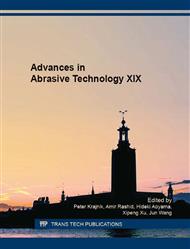p.133
p.139
p.145
p.151
p.158
p.167
p.172
p.178
p.187
Experimental Research of Cluster Magnetorheological Finishing on Anodic Oxide Film of Aluminum
Abstract:
The polishing experiments of anodic oxide film of aluminum were performed to research the influence of polishing parameters on the surface roughness and material removal rate in the cluster magnetorheological finishing (MRF). Experimental results demonstrate that a mirror effect can be reached when the anodic oxide film of aluminum is polished by the Cluster MRF. The roughness of the workpiece surface after polishing for 15 min is decreased from Ra 0.575μm to Ra 4.13nm and the material removal rate is 0.653mg/min. With the extension of the polishing time, the surface roughness rapidly declines at first and then slowly decreases. When the machining time is more than 15min, the anodic oxide film of aluminum is easily worn out, resulting in a sharp increase in the surface roughness. The machining gap between the workpiece and the polishing plate influences the polishing effect of anodic oxide film of aluminum. With the increase of the machining gap, the material removal rate decreases and the surface roughness increases. A good surface quality can be got at the machining gap of 1.1mm. The type and size of abrasive particles will directly affect the polishing effect of anodic oxide film of aluminum, and when using CeO2 abrasive with the particle size of W3, a higher material removal rate and a smaller surface roughness can be obtained.
Info:
Periodical:
Pages:
158-166
Citation:
Online since:
October 2016
Authors:
Price:
Сopyright:
© 2016 Trans Tech Publications Ltd. All Rights Reserved
Share:
Citation:


